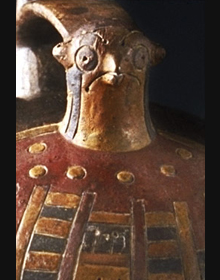resources
Museum Collections - Ancient Peru - Paracas

Paracas, 700 - 1 B.C., was a complex of cemeteries and habitation areas located on the arid Paracas Peninsula on the south coast of Peru. Paracas was discovered in 1925 by the famous Peruvian archaeologist, Julio C. Tello. Tello uncovered hundreds of mummy bundles wrapped in multiple layers of exquisitely decorated textiles, including mantles or shrouds. Sometimes more than sixty layers of textiles covered one mummy. These garments were elaborately embroidered in rich colours of red, dark blue, dark green and yellow. The textiles seem to have been made primarily for inclusion in the mummy bundles (rather than for use by the living).
By 300 B.C., Paracas weavers were using camelid fibre (probably alpaca from the highlands) to fashion tiny figures that decorated the borders of mantles. Paracas ceramics include some post-fired painted pots decorated in earth tones, and monochrome pottery in the shapes of plants and animals. Birds were prominent in the Paracas landscape and appear more frequently than any other animal in Paracas ceramics. This example depicts a falcon, an impressive creature, which is known for its unusual ability to seize other birds in mid-flight.

